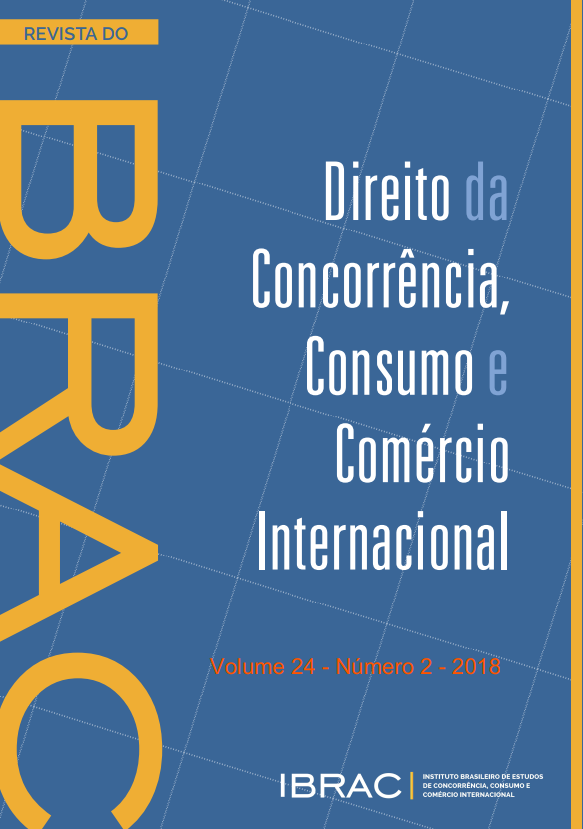Competition policy evaluation through damage estimation in fuel retail cartel
Main Article Content
Abstract
I estimate the fuel retailer cartel damages in the south of Brazil using reduced and structural forms for supply and demand. Brazilian Competition Authority (CADE) documents help to characterize the ethanol and gasoline retailers involved in the collusion. The objective is to evaluate competition policy by comparing the amount of estimated damages with the amount of applied fines. This paper also adds an important result to gasoline substitution, as data shows ethanol is perceived as a perfect substitute and it is
price inelastic. Results show an overcharge of 3.6% to 6.6% in the gasoline market and up to 12% in the ethanol market during collusion. Fines should consider the deterrence effect and, giving the low probability of detection, CADE’s applied fines seemed to be in line with this objective.
Downloads
Article Details
References
Allain, M. L., Boyer, M., Kotchoni, R., & Ponssard, J. P. (2015). Are cartel fines optimal? Theory and evidence from the European Union. International Review of Law and Economics, 42, 38-47.
Anderson, S.T. (2012), The demand for ethanol as a gasoline substitute, Journal of Environmental Economics and Management, 62, 151–168.
Anfavea (2008), Vehicles – production, domestic sales and exports. Available at http://www.anfavea.com.br/anuario2008/capitulo2a.pdf.
Ashurst (2004), Analysis of Economic Models for the Calculation of Damages, Report for DG Comp.
Bonnet, C., & Dubois, P. (2010). Non linear contracting and endogenous buyer power between manufacturers and retailers: empirical evidence on food retailing in France. Mimeo.
Bolotova, Y., Connor, J. M., & Miller, D. J. (2008). Factors influencing the magnitude of cartel overcharges: An empirical analysis of the US Market. Journal of Competition Law and Economics, 5(2), 361-381.
Cade (2010). Processo 08012.011668-2007-30.
Cade (2014), Varejo de Gasolina, Cadernos do Cade.
Cade (2016), Prevenção Ótima de Cartéis: O Caso dos Peróxidos no Brasil. Documento de Trabalho 02/2016.
Clark, Robert C., Houde, Jean-François, 2013. Collusion with asymmetric retailers: evidence from a gasoline price-fixing case in Canada. Am. Econ. J. Microecon. 5 (3), 97–123.
Clark, Robert C., Houde, Jean-François, 2014. The effect of explicit communication on pricing: evidence from the collapse of a gasoline retail cartel. J. Ind. Econ. 62 (2), 191–228.
Connor, J. M. & Bolotova, Y. (2005), Cartel Overcharges: Survey and Meta-Analysis. International Journal of Industrial Organization, Vol. 24, 2006.
Connor, J. M. (2009), Cartels and Antitrust Portrayed: Market Effects and Damages. SSR1 Working Paper.
Covrig, C. (2014), How sugar and ethanol impact each other? Platts McGraw Hill Financial. Available at https://www.platts.com/IM.Platts.Content/ProductsServices/ConferenceandEvents/2014/sc451/presentations/Claudiu-Covrig.pdf
Davis, Peter and Garcés, Eliana (2010), Quantitative Techniques for Competition and Antitrust Analysis, Princeton University Press.
Houde, J. F. (2012), Spatial differentiation and vertical mergers in retail markets for gasoline. The American Economic Review, 102(5), 2147-2182.
Hüschelrath, K., Weigand, J. (2010), A Framework to Enforce Anti-predation Rules. World Competition, Issue 2, pp. 209–240.
Miller, N. H., & Osborne, M. (2014), Spatial differentiation and price discrimination in the cement industry: evidence from a structural model. The RAND Journal of Economics, 45(2), 221-247.
Ministry of Environment (2011), First National Emissions Inventory by Vehicles. Available at http://www.anp.gov.br/wwwanp/images/EmissoesAtmosfericas-1Inventariodeemissoes.pdf.
OCDE (2013), Assessment of the Impact of Competition Authorities’ Activities, DAF/COMP/WP2(2013)1.
OCDE (2013), Competition in Road Fuel, Policy Roundtables.
OCDE (2014), Guide for Helping Competition Authorities Assess the Expected Impact of their Activities.
OCDE (2016), Reference guide on ex-post evaluation of competition agencies’ enforcement decisions.
Oxera and A. Komninos (2009), Quantifying Antitrust Damages. Towards Non-Binding Guidance for Courts, Study prepared for the European Commission, DG COMP.
Petrin, A., & Train, K. (2010). A control function approach to endogeneity in consumer choice models. Journal of marketing research, 47(1), 3-13.
Ragazzo, C. E. J. e R. M. da Silva (2006), Aspectos Econômicos e Jurídicos sobre Cartéis na Revenda de Combustíveis: Uma Agenda para Investigações, Documento de Trabalho SEAE no 40, Secretaria de Acompanhamento Econômico, Ministério da Fazenda.
Salvo, A., Huse, C. (2011), Is arbitrage tying the price of ethanol to that of gasoline? Evidence from the up take of flexible-fuel technology, Energy Journal, 32, 119–148.
Salvo, A., Huse, C. (2013), Build it, but will they come? Evidence from consumer choice between gasoline and sugarcane ethanol, Journal of Environmental Economics and Management, Volume 66, Issue 2, 251-279.
Secretaria de Direito Econômico (2010), Nota Técnica para Averiguação Preliminar, Processo n.º 08012.000642/2010-61.
Verboven, F. and T. van Dijk (2007), Cartel damages claims and the passing-on defense, Working Paper, K.U. Leuven.
Villas-Boas, S. B. (2007). Using retail data for upstream merger analysis. Journal of Competition Law and Economics, 3(4), 689-715.

